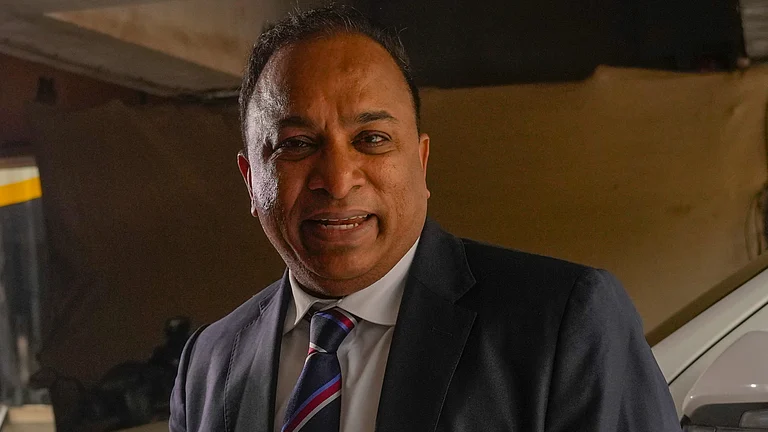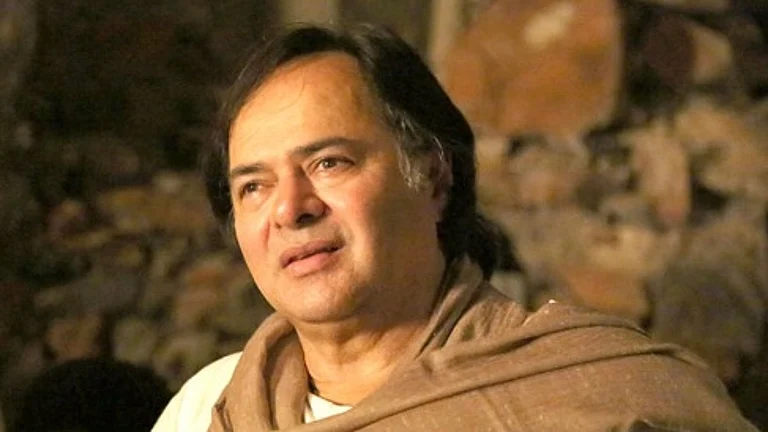It was 2015. Siddharth Bantval of the Indian Paranormal Society (IPS), a group of eccentric professionals, got a call, claiming that some paranormal activities had been detected in a house. Bantval and his team rushed to set up their equipment in the house—CCTV cameras, electromagnetic field (EMF) meters, night vision cameras, IR torches etc. They were told that objects get displaced from their original places, the TV is put on, light flickers and some strange and ghostly noises are heard by the family living there.
“We set up CCTV cameras in their bedroom and started tracking the visuals, but all of a sudden the camera pushed and somebody locked us inside the room. I had only spent a year in IPS, and I was scared,” said Bantval. “But before we started this, we had also asked some questions, the responses to which were inconsistent. So we surmised that the residents are disturbed.”
ALSO READ: Horror As The Theme Of Our Lives
Bantval and his team are “paranormal investigators”. They investigate “haunted locations” for signs of paranormal activity, using electronic devices like digital cameras, EMF meters, dog dazers, etc. “Ghost hunters” accumulate evidence of patterns and coincidences to connect the dots.
A YouTube search about Bhangarh fort in Ajmer, Rajasthan, brings up several videos suggesting paranormal things related to the ruins. It also throws up videos of eccentric content creators interested in “ghost hunting”.
There are several vlogs about visits to the fort, which is said to be Asia’s most haunted place. Amit Sharma, who runs the YouTube channel Crazy XYZ, has made at least four videos on Bhangarh fort, and three of them have over 15 million views each. “The notoriety of Bhangarh makes people visit this fort and look for such content on YouTube,” says Vikash Yadav, a local, who has visited Bhangarh fort several times.
“There is a famous folklore among locals that YouTube has popularised,” Yadav says. The myth goes: a tantric (wizard) fell in love with a queen named Ratnavati. He knew his love would not be reciprocated, so he created a potion to trap her. But she anticipated that and threw the potion on a boulder, which crushed the wizard. While dying, he cursed the fort, and it was subsequently ruined in war. So all those who lived there are trapped inside. However, officials of the Archaeological Survey of India deny this, calling it a “total myth”.
In a video titled Searching ghost in Bhangarh fort at night, Sharma spent hours with an EMF meter to capture any electromagnetic field, indicating the paranormal. The video is wacky and dramatic—but doesn’t bust the myth about the fort being haunted. It did however bust the myth that whoever goes there at night, dies, because he safely spent the night at the fort. However, his other video is not just about “ghost hunting” but includes bewildering stunts, weird hacks and pseudo-science experiments. Many like him make content on ghosts to get “views”, as material that contains surprise and mystery gets a lot of views. Sharma also recorded deviations in his EMF meter, but he left this unexplained.
There are questions of reliability of these devices, as deviations can be linked to something else that is not paranormal. For instance, in Bhangarh fort, it is said that there are underground water flows that cause these deviations.
Content creators like Sagar Tiwari, on his eponymous YouTube channel, had more focused videos on ‘ghost investigations’—with the intent to bust myths about paranormal activity in a place. He visits places notorious for evil spirits.
In 2019, the Delhi-based YouTuber decided to make a career busting myths about haunted places. “It all started with a dare. My friend asked me to visit a haunted place in Lajpat Nagar and I did and made a video about it.” Sagar is inspired by Gaurav Tiwari, a celebrated ‘ghost investigator’ and founder of Delhi-based IPS, who had frequently appeared on TV shows and news before he died allegedly by suicide in 2016. “Gaurav Tiwari brought this profession to notice in India. I started to follow his work and got inspired,” Sagar says. Now, his channel has around 3 lakh subscribers.
Waqar Raj, the technical head of IPS, is one of the leading names in India for tracking ‘paranormal’ activities, taking forward the legacy of Gaurav Tiwari with his own non-profit organisation. Raj says in his videos on YouTube that “Paranormal has no future in India. I do it as a hobby and for my friend Gaurav Tiwari.”
Sagar too believes this profession has a lot of challenges because the government doesn’t recognise it. “Since the profession is not recognised, no professional course is available in India. If I want to study it, I can’t.”
“We face a lot of hurdles. Most of the time I don’t get a permit to visit such notorious places. Police and locals eye me with suspicion. We don’t have any income source except YouTube,” he adds.
ALSO READ: The Ghost As A Metaphor In Bengali Cinema
Several ghostbusters that Outlook contacted felt they didn’t find any ‘paranormal activity’ in the most notoriously haunted places like Dumas Beach in Surat and Sanjay Van in Delhi. “Often, I saw there were some vested interests that had created a myth about some evil spirit, so that people don’t try to buy or visit it, especially in the case of private properties,” says Sagar. “I’ve also observed that some people behave eccentrically due to psychological reasons, which people call an evil spell.”
Giving the example of Bhangarh fort, Sagar adds, “The myth serves a purpose. Bhangarh’s haunted tag made it a tourist destination. People come from across the world to visit ‘Asia’s most haunted place’.” Also, “Ghost stories deter people from damaging the fort, which otherwise requires a big police contingent to protect.”
ALSO READ: The ‘Spirit’Of Filmmaking
Though ghost investigation may not seem an attractive career for many, for YouTubers, it is. Content creators like Deepak Verma, with his channel The Real One, and Rajesh Meena of Exploring India are garnering millions of views and attracting sponsorships from various brands. Their content, like that of Sagar Tiwari, is systematic and focuses on “ghost busting”. But unlike in the West, their content is more “wacky” and “daring”.
In India, ghost investigation is a niche market. Not many people know about it. “We help people by bursting myths and creating awareness,” says Sagar. But “the government doesn’t consider this,” says Sagar.
"Our profession is serious. We respect our clients and their privacy and don’t make clickbait,” says Bantwal, adding "IPS has its own YouTube channel since 2012, but “we’re not content creators, we are certified professionals trained by Gaurav Tiwari.”
***
On YouTube, there are umpteen videos of ghost stories and myths. Even mainstream news channels have done stories of haunted places—investigating the “presence of ghosts”—sometimes refuting the paranormal with scientific evidence. But many a time, they propagate myths, fuelling the curiosity of people based on unscientific myths and age-old folklores.
In an article in the Harvard Business Review, professors Haiyang Yang and Kuangjie Zhang explain, “Some research indicates that people with a higher sensation-seeking trait (i.e., a stronger need for experiencing thrill and excitement) tend to seek out and enjoy horror-related experiences more. Those with a lower sensation-seeking trait may find these experiences unpleasant and avoid them.” Also, content with an element of curiosity increases interest.
ALSO READ: Resident Evil: The Zombie Apocalypse In Goa
In an India riven by superstition, myths, ghosts and evil spirits, social media has amplified consumption of such content. “An armyman once wrote to me that after watching my video, he felt confident to go out and take a leak at night,” says Tiwari. “He was scared of ghosts, because in a place where he was deployed, someone had told him ghost stories and scared him. My audience includes many lawyers and judges who grew up listening to ghost stories,” Tiwari adds.
Another popular theme on social media is the prank video, which gets a lot of traction. Ghosts in stereotypical white clothes and long hair slowly walking towards people to scare them, has become a popular template for such content.
***
Sristhi Gurjar (name changed) was in college when she heard there was some spirit in her hostel room. “After hearing rumours, I started believing them,” she says. She started watching videos related to ghosts and similar stuff on social media. “I got two anxiety attacks in a year, and even considered dropping out.”
For Sristhi, horror-related content gives relief. A few researchers say that in some cases, watching horror films can help cope with trauma. A research paper published in the journal Science Direct, titled Dissociable neural systems for unconditioned acute and sustained fear, says, “Anticipatory fear increases functional connectivity between anticipation and response networks.” This interaction is “dynamic”, and in some cases can also adversely affect people.
Rumours spreading in digital space also keep people engaged and force them to consume more content around it. Harmful games like ‘Momo Challenge’ and ‘Blue Whale’, where kids and adolescents were allegedly targeted to perform self-harming tasks—get huge traction in all media. Investigations, for instance into the “Blue Whale” game, revealed there aren’t many users of it. Despite that, they are all over the internet, preying on the curiosity of people.
***
In an interview, Anand Gandhi, the creative director of the movie Tumbbad, said horror stories across the world weave in human emotions like revenge, guilt, sin, greed or patriarchy. And popular ghosts stories emanate from such emotions.
ALSO READ: An Allegory Written In Blood
In India, ghost stories have characters like “disgruntled wizard”, “slaves”, “vengeful souls of cheated people”, etc. The moralistic underpinning and re-telling of old folklores with more twists, provide a commentary on dynamic changes in society. A lot of this content is repackaged on social media and later goes viral, because people want such content.
Many people told Outlook that they heard stories about “the spirit of a woman taking revenge for mistreatment”, “spirits of a family trapped by unfulfilled purpose”, etc, and got curious. For instance Malcha Mahal in Delhi’s Chanakyapuri, on which you will not only find YouTube videos, but also videos of ghost stories with millions of views.
No wonder Bollywood keeps returning to the haunted house for inspiration.
(This appeared in the print edition as "Desi Ghostbusters")
ALSO READ


























